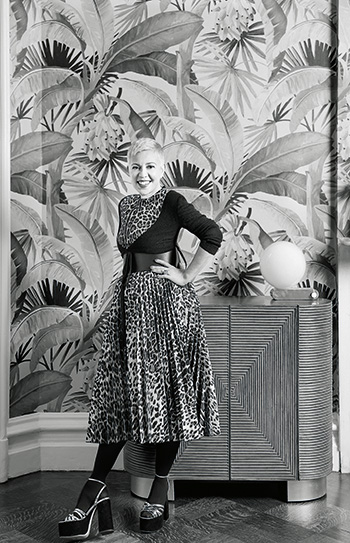Catherine Martin’s Maximalist Movie Sets and Costumes Inform Her Textiles and Wall Coverings
 Iconic is a word often bandied about, seldom deserved. But the creative partnership of filmmaker Baz Luhrmann and his wife Catherine Martin—the design doyenne behind the sets and costumes of his heady, immersive movies—has surely earned its right to the ubiquitous adjective.
Iconic is a word often bandied about, seldom deserved. But the creative partnership of filmmaker Baz Luhrmann and his wife Catherine Martin—the design doyenne behind the sets and costumes of his heady, immersive movies—has surely earned its right to the ubiquitous adjective.
The Australian couple’s three-decade-long creative alliance began during Martin’s final year at Sydney’s National Institute of Dramatic Art, when Luhrman hired her to design an opera set.
Since then, CM, as she’s affectionately known, has overseen most of his stage and screen productions—Strictly Ballroom, Romeo + Juliet, Moulin Rouge!, Australia, The Great Gatsby, and La Bohème on Broadway, among them—garnering four Oscars and a Tony Award along the way.
Martin’s additional design duties include a burgeoning homewares line; merchandise and window displays for the likes of Tiffany & Co. and Barneys New York; hotel interiors (the Latin-deco Faena Miami Beach and a Gatsby-inspired suite at the Plaza, New York); and, most recently, textiles and wall coverings sparked by Marrakesh’s Jardin Majorelle for New Zealand brand Mokum.
Interior Design: You’ve designed for film, television, and theater, created window displays and homewares, even guest edited a design magazine. All of which are “world-creating.” Is that how you see it?
Catherine Martin: Design is an applied art form. It’s about solving problems, understanding the rules of the game, and understanding success—not in a financial or self-serving way, but what meets the criteria for winning the challenge. That’s what excites me.

ID: What has Baz taught you—and vice versa?
CM: As an applied artist, I attach myself to an existing vision. I’ve had the pleasure to work with my husband—a storyteller—for the last 30 years. Baz will come up with an idea and tell it to me; he has the ability to know what is going to reveal the story. I’m good at translating that into reality. I enjoy the practical side of the puzzle. As much as I complain about the bore of having to make everything to a budget, it’s part of the game. What’s the most elegant solution to a given problem? How do you tell a story for $5—or $50,000? Both scenarios have inherent challenges.
ID: What’s the process of making a set?
CM: Everything needs to be researched, sketched, shown to the director, changed, and eventually approved. Then it goes through a detailed technical drawing phase that needs to be costed. Eventually, you end up with a scheme that is in budget, and you’re ready to construct. That’s when a whole team of people comes in: metalworkers; carpenters; painters; plasterers, who do more than just mold cornices—for Australia, they constructed a huge boab tree from casts they’d made in the outback; sculptors, who made the human molars worn as cufflinks in Gatsby; wardrobe; milliners; jewelry makers; art finishers, who do anything from sandblasting objects so they look old to painting and dyeing them. And there’s a big graphics department—because of possible litigation, you can’t just reproduce existing product logos and labels, you’ve got to create new ones.

ID: How do you research? I noted a formidable library in your New York home.
CM: Because F. Scott Fitzgerald cared a lot about clothes, most of the costumes for The Great Gatsby movie were actually described in the novel. That was the starting point. From there, I tried to find evidence of clothing in existence in 1925 that looked like those descriptions. I love books, especially fashion reference and photography. One favorite is of works by the 19th-century documentary photographer Eugène Atget. He recorded Paris architecture and street scenes—things that are very interesting to me because they contain the tale of everyday life.
ID: You’ve worked with Mokum for some time on textiles and wallpaper. What inspired the new collection?
CM: I’ve always greatly admired the interiors that living-legend Jacques Grange designed for Yves Saint-Laurent in Marrakesh. I love the juxtaposition and layering of luxurious textures and patterns. It takes a lot of courage and skill to be able to do that French-Moroccan crossover.

ID: What was your aim for the collection?
CM: Practical luxury. I don’t design anything I wouldn’t want in my own life. It’s great to have products that are aspirational but affordable, good quality, and can survive the ravages of time, dogs, kids, Nutella. That’s my hope, to make products for livable spaces. I was very tedious about the new wall coverings: To meet fire codes for commercial applications, such as hotels, they had to be printed on vinyl—I was very suspicious of that. But, in fact, the product has surpassed my expectations. Texturally, it’s incredible.
ID: What’s on the horizon?
CM: I’m working on one of Baz’s movies now, and an upcoming range for Mokum. For my own line, Catherine Martin Home, I’d love to do candles, home fragrances, and eventually tableware and furniture.
> See more from the Fall Homes 2018 issue of Interior Design


